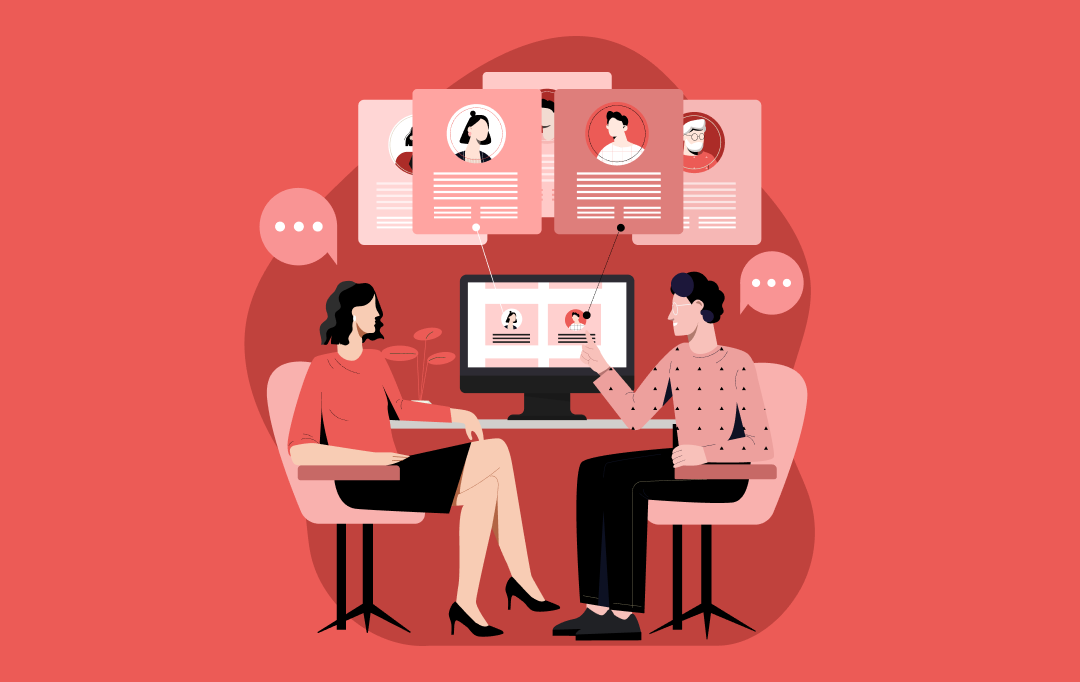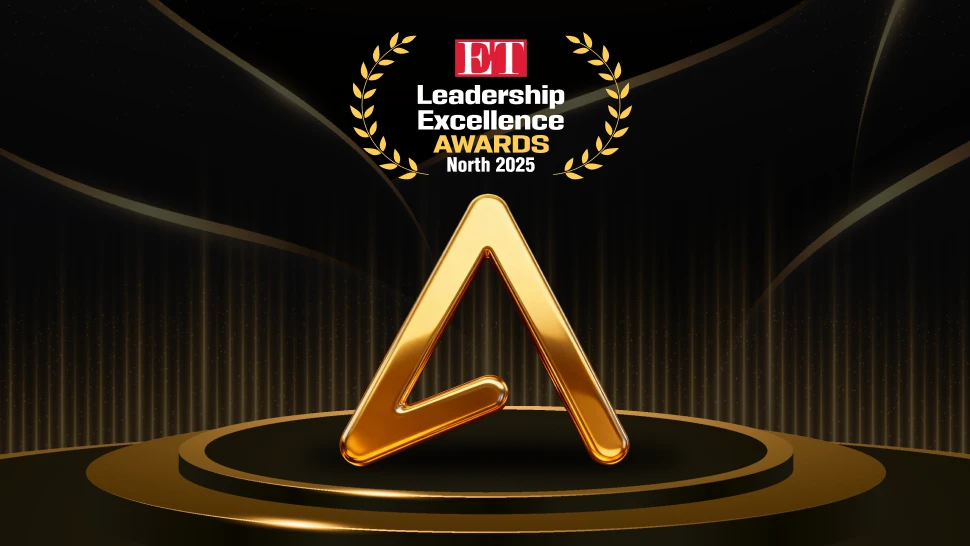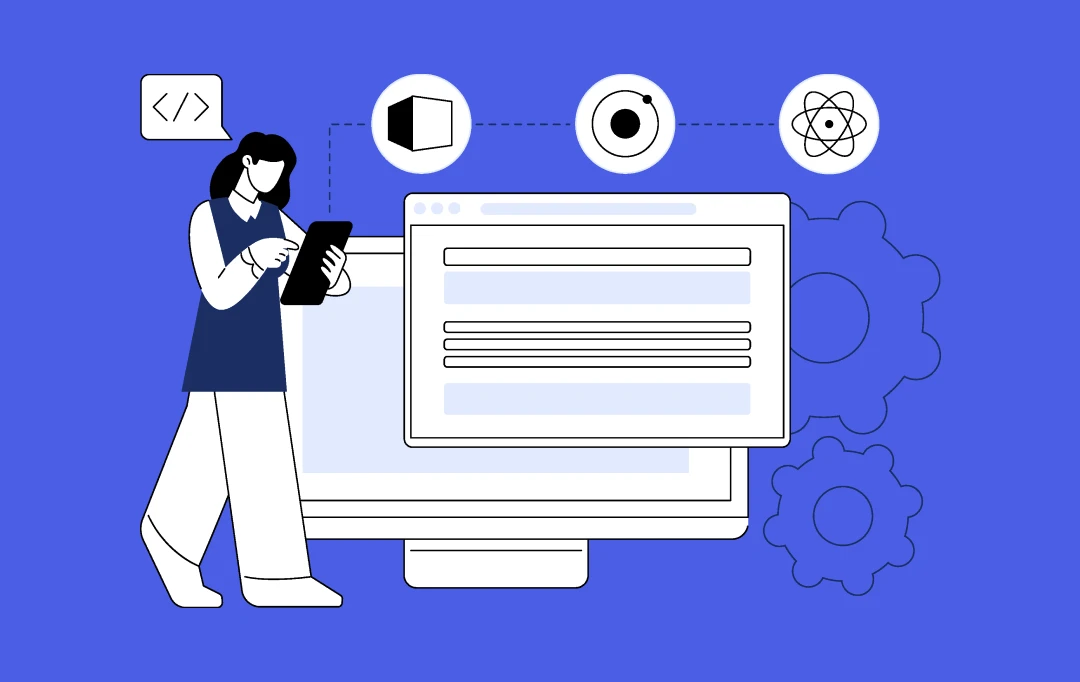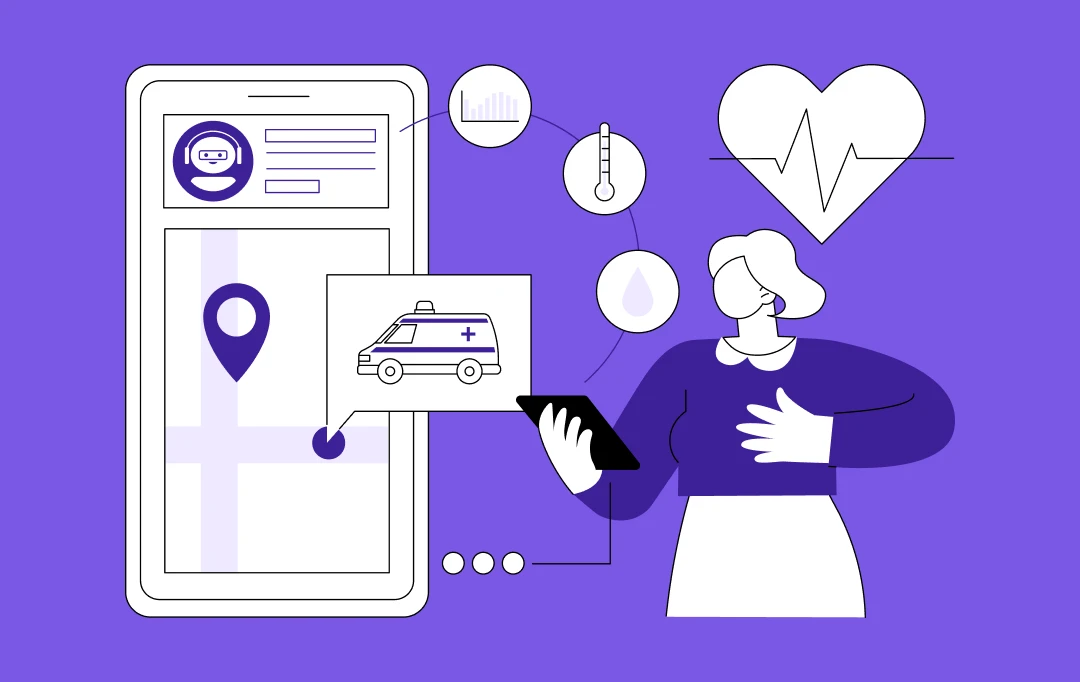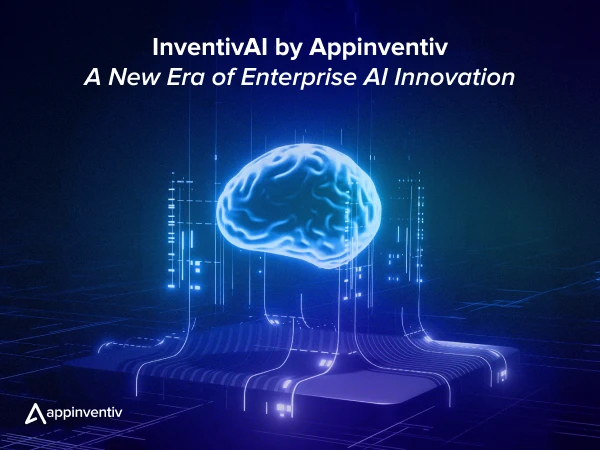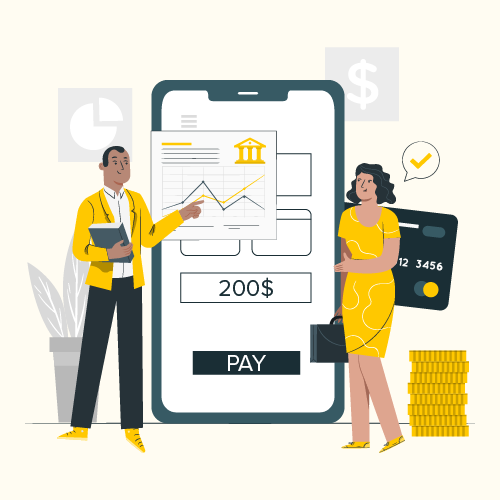- Understanding the Indispensable Role of APIs in Today’s Digital World
- Comprehending the Pool of API Development Terminologies
- API Development Tools and Technologies
- How Does API Work?
- Unveiling the Various Types of APIs
- Open APIs (Public APIs)
- Partner APIs
- Internal APIs (Private APIs)
- Composite APIs
- Web APIs
- Enterprise API Use Cases Across Industries
- Must-Have Features of an Efficient API
- Modification Timestamps/Investigation Filters
- Paging
- Sorting
- Fast performance and high availability
- Scalability
- Authentication and Authorization
- Caching
- Rate Limiting
- API Versioning
- Detailed Logging and Monitoring
- Comprehensive Documentation
- How to Build an API - A Step-by-Step Process
- Define Your Purpose and Requirements
- Design the API Architecture
- Choose the Right Tech Stack
- Document the API
- Implement Authentication and Authorization
- Test Rigorously
- Deploy and Integrate APIs
- Monitor, Analyze, and Iterate
- API Development Best Practices that Grows and Scales
- Use Throttling
- Add Rate Limiting
- Consider the API Gateway as an Enforcer
- Allow Overriding the HTTP Method
- Evaluate the APIs and Infrastructure
- Use JSON Support/ REST
- Authorize via OAuth
- Ensure API Security
- Start with Versioning
- Make Room for Caching
- Create a Documentation
- Don’t Skip Automated Testing
- API Development Challenges and How to Overcome Them
- Understanding the API Development Cost
- API Monetization Strategies: Building New Revenue Channels
- Usage-Based Pricing
- Freemium to Premium API Access
- Revenue Sharing with Partners
- The Future of APIs: Powering the Next Digital Revolution
- API-First Development Becoming Standard
- Growth of Low-Code and No-Code API Solutions
- Expansion of API Security Frameworks
- Surge in API Monetization Models
- Growth of Multi-Cloud and Hybrid API Deployments
- Increased Use of AI-Driven APIs
- Greater Emphasis on Real-Time APIs
- Partner with Appinventiv for Efficient API Development
- FAQs
Speed is the new currency. Whether it’s onboarding new customers, enabling instant payments, or connecting global platforms—businesses that can’t move fast, lose fast. And behind this speed? APIs.
APIs (Application Programming Interfaces) have quietly become the infrastructure powering modern business growth. They are the reason fintech apps can verify bank details in seconds, retailers can offer real-time inventory updates, and SaaS platforms can integrate effortlessly with hundreds of other tools. APIs don’t just connect systems—they unlock entirely new business models.
Global leaders like Stripe, Plaid, and Twilio aren’t just API providers—they’re ecosystem builders. Their APIs help thousands of businesses scale, automate, and innovate without rebuilding core infrastructures from scratch. The result? Faster go-to-market, reduced operational costs, and superior customer experiences.
According to a Forbes report, companies that strategically adopt APIs can drive up to 12.7% higher market capitalization and dramatically increase customer retention by offering connected, frictionless services.
This guide is built for businesses looking to:
- Understand how APIs create growth opportunities
- Build secure, scalable, and high-performance APIs
- Select the right tools, technologies, and partners for API development
- Master best practices to ensure long-term success
If you’re building products that need to scale, integrate, and perform flawlessly—API development is not optional. It’s the foundation that will keep your business relevant, fast, and future-ready.
Let’s break it down.
Understanding the Indispensable Role of APIs in Today’s Digital World
APIs (Application Programming Interfaces) are no longer just backend connectors—they are strategic assets that power scalable, real-time, and integrated digital ecosystems. In simple terms, APIs act as structured communication channels that allow different software systems to exchange data securely and efficiently. They are the foundation of seamless connectivity, whether across internal platforms or with third-party services.
For enterprises, developing an API is not about just enabling technical communication—it’s about accelerating product innovation, reducing time-to-market, and building competitive advantage. APIs eliminate the need to build redundant functionalities from scratch by unlocking the ability to integrate existing platforms and services, thereby focusing engineering efforts on value-driven features.
Take the example of API integration development in mobile apps—when a user clicks on ‘Login with Google’ or ‘Connect Facebook’ in a SaaS or gaming app, they instantly access the service without entering their credentials again. This frictionless experience is made possible by creating APIs that facilitate secure data sharing in real-time. These API development examples demonstrate how APIs simplify the api development and integration process while enhancing customer experience.
Now let’s move on and explore the basic terminologies that power API development and integration.
Comprehending the Pool of API Development Terminologies
Understanding how to build an API and its functioning starts with getting familiar with its core terminologies. From authentication keys and endpoints to protocols like REST and SOAP, each term plays a crucial role in defining how APIs simplify complex programming tasks. This section breaks down the most essential API concepts to help you navigate development with clarity and confidence.
| API Development Terminologies | Definition |
|---|---|
| API Key | When an API request is made through a header or parameter to recognize the requester, the authorized code passed into the request is said to be an API Key. |
| Endpoint | When an API interacts with another system, one end of the communication channel is termed an Endpoint. |
| JSON | JavaScript Object Notation (JSON) is a data format for API request parameters and response bodies. |
| GET | The RESTful application program interface’s HTTP method of obtaining resources is called GET. |
| POST | It is the RESTful API’s HTTP method for building resources. |
| OAuth | It is an Open standard authorization framework that renders access from the user’s side without directly sharing the credentials. |
| REST | REST (Representational State Transfer) is a programming architectural implementation to enhance communication efficiency between two devices/systems. |
| SOAP | SOAP or Simple Object Access Protocol is a messaging protocol for sharing structured information to execute web services in computer networks. |
| Latency | Latency is defined as the total time taken by the API interface in the process from the request to the response. |
| Rate-Limiting | API Rate-limiting refers to defining the rate at which an end user can access the APIs. |
| API Throttling | The process of regulating the usage of APIs by users during a particular time is called API Throttling. This can be used for API limiting. |
API Development Tools and Technologies
There are a plethora of API design tools and technologies involved in the process of creating APIs. The table below outlines some popular API development technologies used to deliver cutting-edge API development services:
| API Development Tools | Description |
|---|---|
| Apigee | It is Google’s API management provider that assists users in triumphing at digital transformation by re-establishing an API Integration development approach. |
| APIMatic and API Transformer | These API development tools offer advanced automation capabilities to generate high-quality SDKs and code snippets. |
| API Science | This tool is primarily used to evaluate the performance of internal and external APIs. |
| API Serverless Architecture | API serverless architecture assists in designing, building, publishing, and hosting APIs using a cloud-based server infrastructure. |
| API-Platform | This is one of the open-source PHP frameworks that is apt for web API integration development. |
| Auth0 | It is one of the most widely used API development tools for authenticating and authorizing APIs. |
| ClearBlade | It is an API management provider that embraces IoT technology in API development services and integration process. |
| GitHub | This open-source Git repository hosting service lets API developers manage code files, pull requests, version control, and commenting that are distributed across the group. |
| Postman | It is basically an API toolchain that empowers API developers to run, test, document, and evaluate the performance of their API. |
| Swagger | It is an open-source framework that is used for API software development. Big technology giants such as Getty Images and Microsoft use Swagger. |
| Kong | An emerging API gateway and management tool offering high-performance traffic handling, security policies, rate limiting, and monitoring for microservices APIs. |
| RapidAPI | A popular API marketplace and management tool that allows API developers to discover, connect, and manage thousands of APIs from a single hub. |
| AWS API Gateway | A fully managed service from AWS that helps API developers build, deploy, and manage APIs at scale with integrated support for monitoring, throttling, and authorization. |
Now that you are familiar with the API development technologies and terminologies associated with creating an API, let’s dive deeper to uncover how an API works and how to create an API.
How Does API Work?
APIs act as the bridge between applications and data. When a user interacts with an app, the API sends a request to a server or database for specific information. The server processes this request and sends the data back via the API, which the app then displays to the user. This seamless exchange powers everything from logging in to making payments or fetching live updates.
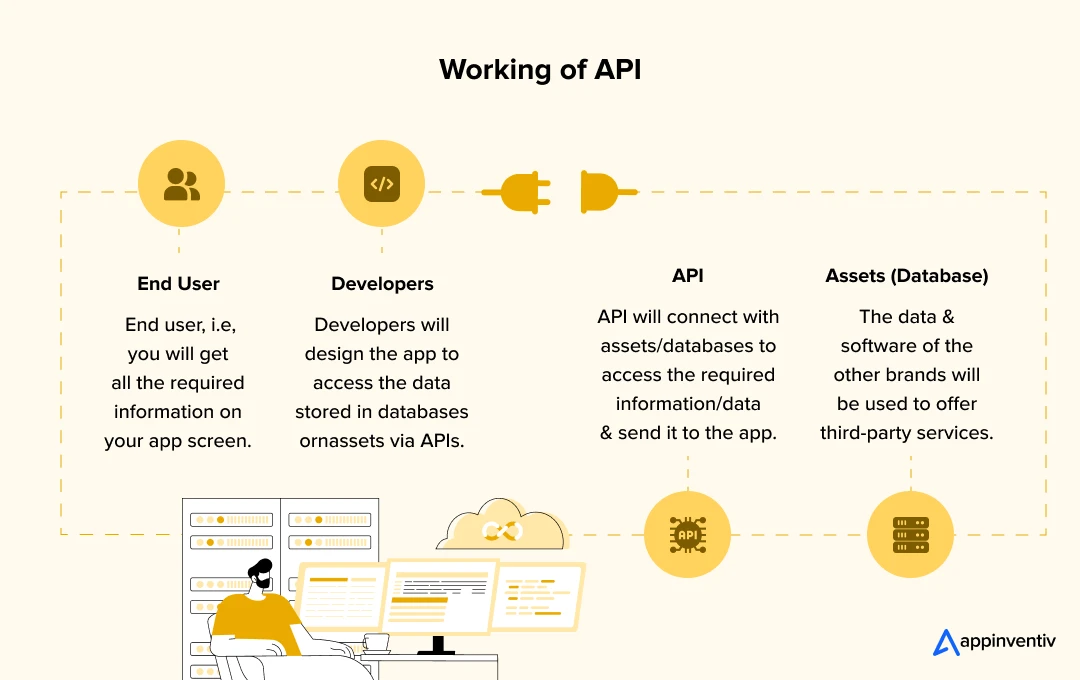
Take an API development example of a flight booking app/website. You filled out the form, entered the departure and return date, city, flight, and other relevant details, and submitted. Within a fraction of a second, a list of flights appears on the screen along with the price, timings, seat availability, and other details. How does this happen?
To provide such stringent data, the platform requested the airline’s website to access their database and get relevant data via the API interface. The website responded with the data that the API delivered to the platform, and the platform displayed it on the screen.
Here, the flight booking app/platform and the airline’s website act as endpoints, while the API is the intermediate, streamlining the data sharing process. When communicating the endpoints, the API works in two ways: REST and SOAP (see definition above). Though both methods produce effective results, an API development company often prefers REST over SOAP since SOAP APIs are heavy and platform-dependent.
Let’s take another API development example: creating a RESTful API for a food delivery app. The API allows users to register, log in, browse restaurants, place orders, and track deliveries. It connects the front end with the backend database and services, enabling seamless data exchange between users, restaurants, and delivery personnel.
Unveiling the Various Types of APIs
APIs come in different forms depending on their architecture and scope of use, each designed to address a specific connectivity challenge. Whether opening up services to the public, streamlining internal operations, or connecting businesses with partners, there is an API for every need. Let’s unveil the curtain and explore the different types of APIs silently working in the background and powering everything from your favorite apps to complex enterprise systems.
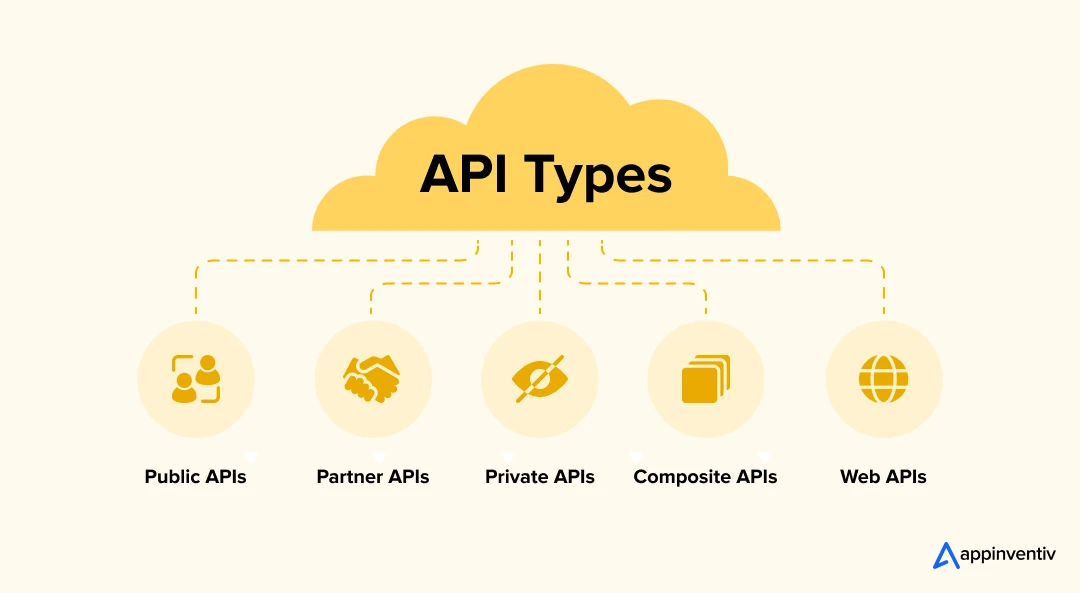
Open APIs (Public APIs)
Open APIs, also known as public APIs, are accessible to external developers and businesses with minimal restrictions. These APIs are often used to expand reach and accelerate third-party integrations. Companies that focus on API software development leverage Open APIs to quickly scale their services and build broader ecosystems without heavy internal dependencies.
Partner APIs
Partner APIs are designed for secure, controlled access by specific external partners. Unlike public APIs, they allow businesses to collaborate with vendors and strategic allies while maintaining strict control over shared data. Developing an API for partner integration ensures seamless communication and reliable service delivery between connected platforms.
Internal APIs (Private APIs)
Internal APIs, often called private APIs, are used exclusively within an organization. They improve efficiency by allowing different internal systems, tools, and applications to interact securely. These APIs are particularly valuable when building connected solutions like API for mobile apps, where internal data and services must sync quickly and reliably.
Composite APIs
Composite APIs combine multiple service calls into a single request, making it easier to execute complex processes efficiently. By reducing the number of round-trip requests, they help improve system responsiveness and overall user experience. Enterprises often choose Composite APIs to simplify data aggregation across interconnected platforms and streamline multi-step workflows.
Web APIs
Web APIs enable communication between applications over the internet using standard protocols such as HTTP. They play a crucial role in modern application development, allowing services like payment gateways, cloud storage, and customer portals to integrate seamlessly. For API developers, Web APIs offer a flexible, scalable way to connect web-based and mobile applications with backend systems.
Enterprise API Use Cases Across Industries
APIs are not just technical connectors—they are growth enablers that drive efficiency, scalability, and revenue across industries. CEOs and CTOs are looking for solutions that deliver business impact—faster customer onboarding, improved compliance, real-time insights, and seamless integrations with partners.
Here’s how API development is powering success across key industries.
| Industry | API Use Case | Business Impact |
|---|---|---|
| Fintech | Real-time payment processing, Open Banking APIs, Fraud Detection APIs | Enables instant transactions, smooth bank integrations, and secure customer onboarding. APIs drive the core of digital wallets, payment gateways, and neobanks. They also allow regulatory compliance with open banking mandates. |
| Healthcare | Secure Electronic Health Record (EHR) integrations, Telemedicine APIs, Wearable Device Data APIs | Facilitates secure patient data exchange while meeting HIPAA and GDPR standards. APIs support virtual care, remote patient monitoring, and real-time health analytics, improving care delivery and patient outcomes. |
| Logistics | Real-time shipment tracking, Route optimization APIs, Warehouse management APIs | Offers real-time visibility of shipments, enhances last-mile delivery, and optimizes routes for faster, cost-effective logistics. APIs enable seamless integration between carriers, fulfillment centers, and customer platforms. |
| Retail & eCommerce | Multi-channel inventory sync, Personalized recommendation APIs, Payment gateway integrations | Improves customer experience with real-time stock updates, targeted offers, and frictionless checkouts. APIs help manage dynamic pricing, customer loyalty programs, and third-party logistics (3PL) integrations. |
| Manufacturing | IoT device integration APIs, Supply chain management APIs, Predictive maintenance APIs | Provides real-time equipment monitoring, automates supply chain visibility, and reduces downtime through predictive maintenance. APIs facilitate seamless MES (Manufacturing Execution System) and ERP integrations. |
| Travel & Hospitality | Booking engine APIs, Multi-channel pricing APIs, CRM integrations | Enables real-time booking, price adjustments, and dynamic packaging across platforms. APIs allow travel companies to offer personalized itineraries, loyalty management, and partner inventory access. |
| Education | Learning Management System (LMS) APIs, Online assessment APIs, Video streaming APIs | Supports seamless integration of e-learning platforms, personalized content delivery, and real-time exam processing, enabling hybrid and remote learning experiences. |
| Real Estate | Property listing APIs, Payment gateway APIs, Geolocation and map APIs | Automates property updates, enables instant booking and payments, and provides location-based services to enhance property search and buying experiences. |
| Energy & Utilities | Smart meter data APIs, Grid management APIs, Renewable energy monitoring APIs | Facilitates real-time energy tracking, improves grid stability, and enables seamless integration of renewable energy sources across the power ecosystem. |
| Media & Entertainment | Content delivery APIs, Subscription management APIs, Real-time streaming APIs | Enables personalized content delivery, automated subscription handling, and high-quality real-time streaming experiences across platforms and devices. |
| Automotive | Vehicle tracking APIs, Connected car APIs, In-vehicle infotainment APIs | Supports real-time fleet management, predictive maintenance alerts, and seamless integration of navigation, music, and app services within connected cars. |
Must-Have Features of an Efficient API
Although the world is full of APIs, there is still a major gap in utilizing the perks of API technology. While some APIs make integration to the app a breeze, others turn it into a nightmare. To help you develop one that drives tangible outcomes, here are some of the efficient API features you must consider when building an API:
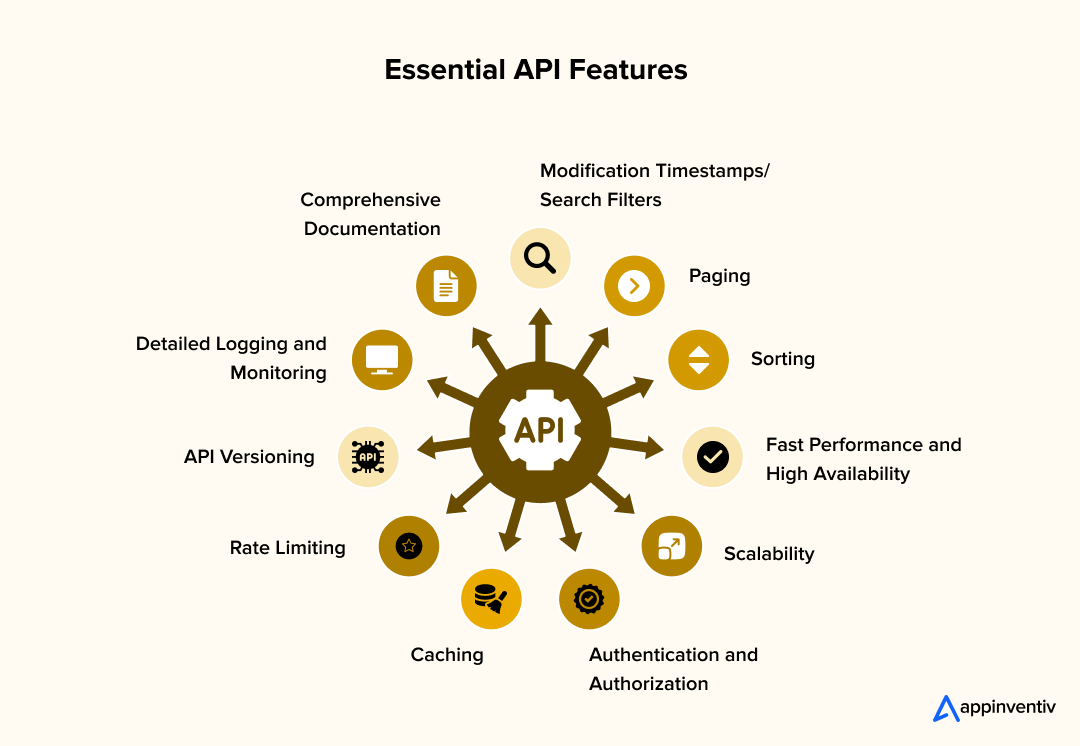
Modification Timestamps/Investigation Filters
The foremost API feature that an app should have is Modification timestamps/Search by criteria. An API should let users search data based on different criteria, like a date. This is because we consider the changes (update, edit, and delete) just after the initial data synchronization.
Paging
Many times, we do not want to see the complete data changed, but just a glimpse of it. In such a scenario, the API should be capable of determining how much data to display in one go and at what frequency. It should also inform the end user about the number of pages of data remaining.
Sorting
The API should have a sorting feature to ensure that the end user receives all the pages of data one by one. This feature empowers users to sort data according to the time of modification or some other condition.
Fast performance and high availability
An API should be responsive and quick, no matter the load. Minimal processing time, low latency, and near-zero downtime are key indicators of a well-built, user-focused API. so, when building an API, ensure it adheres to these parameters.
Scalability
A good API should be efficient enough to handle growing traffic smoothly. So, when creating APIs, ensure they can scale with time to handle tomorrow’s load. Whether your user base spikes or data volumes surge, your API should scale without slowing down or crashing under pressure.
Authentication and Authorization
One of the most essential API features for modern businesses is robust security. Every API should support secure authentication using protocols like OAuth 2.0 and token-based access. Proper authentication and authorization protect sensitive enterprise data and prevent unauthorized usage, especially when developing APIs that integrate with external platforms.
Caching
Caching helps APIs respond faster by temporarily storing frequently requested data. When creating APIs, using effective caching mechanisms reduces server load and significantly improves the user experience, especially for high-traffic APIs where real-time responses are critical.
Rate Limiting
Rate limiting controls how many API requests a user or application can make within a defined period. This feature is essential to prevent server overload and to maintain system stability. When focusing on how to build an API for scalable platforms, rate limiting is a must to protect against misuse and maintain optimal performance.
API Versioning
API versioning ensures that new updates or changes to an API do not break existing applications or services that rely on previous versions. It provides backward compatibility and allows API developers to roll out improvements without disrupting current users. Enterprises must prioritize this feature when thinking about how to create an API that evolves over time.
Detailed Logging and Monitoring
Logging and monitoring are critical for tracking API performance, detecting issues, and ensuring continuous uptime. Effective APIs should offer detailed logs for each request and provide monitoring tools to give real-time insights into API health. This helps API developers identify potential problems early and supports seamless maintenance.
Comprehensive Documentation
High-quality documentation is a core API feature that directly impacts developer adoption and integration speed. When creating APIs, it is essential to provide clear, well-structured, and up-to-date documentation that covers authentication, available endpoints, error handling, and practical examples.
How to Build an API – A Step-by-Step Process
Building an API is about writing code and creating a powerful bridge that connects different digital systems. Following a structured step-by-step process and best practices, you can create robust and efficient APIs that integrate with your systems and scale efficiently as your business grows. Not sure how to make an API? Worry not. Here is a general outline of the steps involved in developing an API:
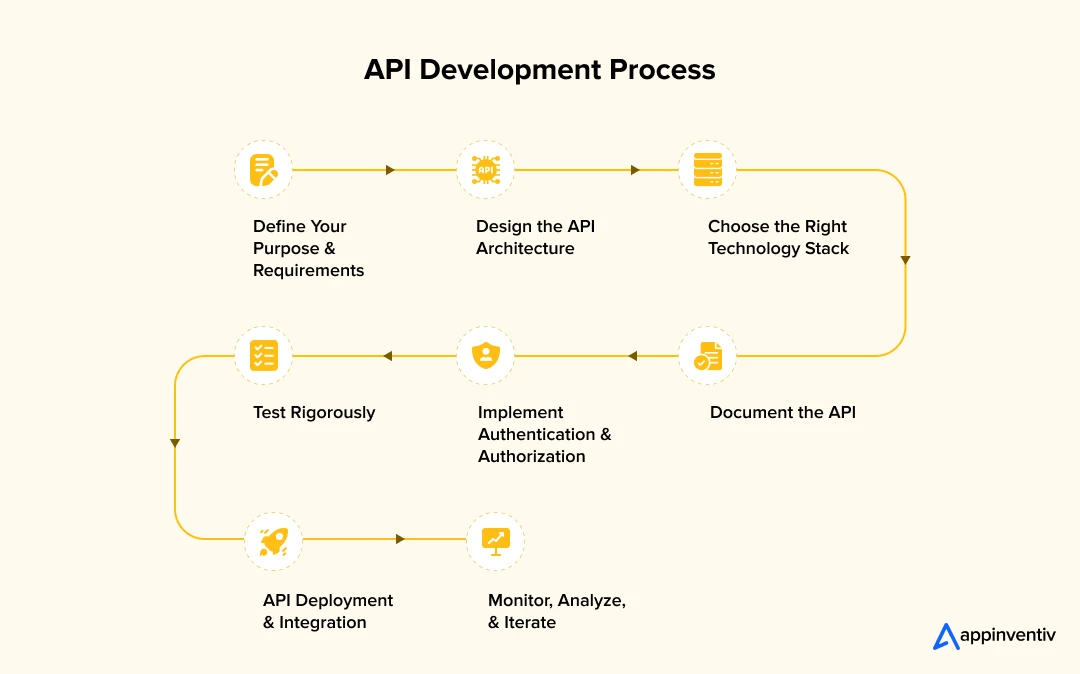
Define Your Purpose and Requirements
Before you begin the API development process, be clear about exactly what you want your API to achieve. List the problems it will solve, the users it will serve, the kind of data it will expose, and the operations it must perform.
Design the API Architecture
Once you have defined your objectives, it is time to craft the API structure. Design the resources, endpoints, request and response formats, and error handling flows. When designing the API architecture, focus on making it intuitive and scalable.
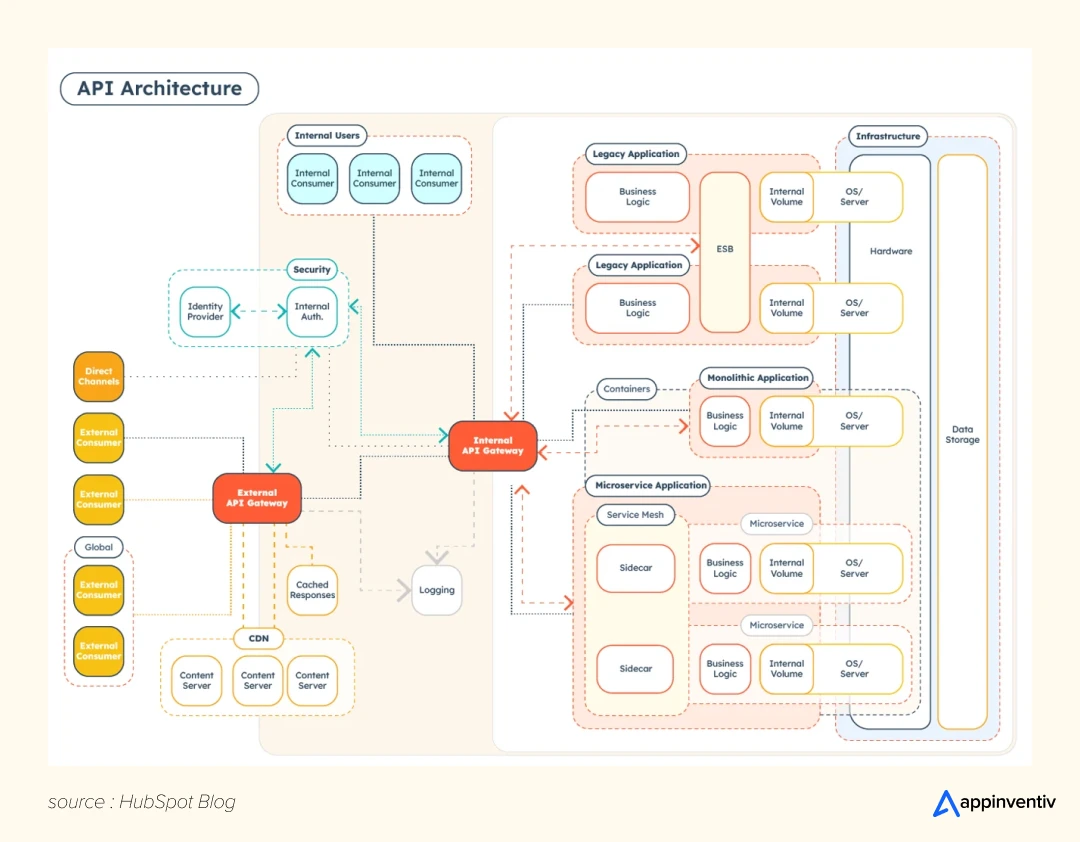
Choose the Right Tech Stack
It is time to choose the right API development technologies, tools, languages, and frameworks that best fit your needs. Ensure the tech stack you choose will make your API development services flexible, speedy, and scalable.
Document the API
Good documentation is essential for developer adoption. Explain how the API works, the available endpoints, authentication methods, expected responses, error codes, and any specific requirements or constraints. API development tools like Swagger (OpenAPI) can help automate this process.
Implement Authentication and Authorization
Security must be baked in from the beginning of the API development process. Thus, you must implement robust authentication methods like OAuth 2.0, API keys, or JWTs to protect your endpoints and manage user access.
Test Rigorously
Testing is not optional; it is indispensable. Before you connect your API to the systems, conduct thorough testing to make sure your API performs well under different conditions. This integral phase can help catch bugs early and maintain stability as you scale.
Deploy and Integrate APIs
Once you have completed the testing and are assured of its quality, you can deploy the API to the targeted platform. Ensure your deployment pipelines are smooth and offer clear guidelines for integrating your API into different applications or services.
Monitor, Analyze, and Iterate
Launching your API is just the beginning. The API development process does not end here. After integration, you need to continuously monitor its performance to track usage patterns, error rates, and system health to spot new opportunities and iterate the API accordingly.
Partnering with an experienced API design and development agency can simplify the entire API development process, from strategy and architecture to deployment and maintenance. Such agencies offer the technical expertise, security best practices, and scalable solutions businesses need to build reliable, future-ready APIs efficiently.
After looking into the detailed process of how to develop an API, let us move ahead and look into the best API development practices that businesses must ensure to build secure, scalable, and easily maintainable APIs.
API Development Best Practices that Grows and Scales
To truly future-proof your API and ensure it can handle scale, flexibility, and ease of use, you should keep a few API development best practices in mind. Here are some tried and trusted strategies you must contemplate when seeking the answer to how to make an API that drives real results:
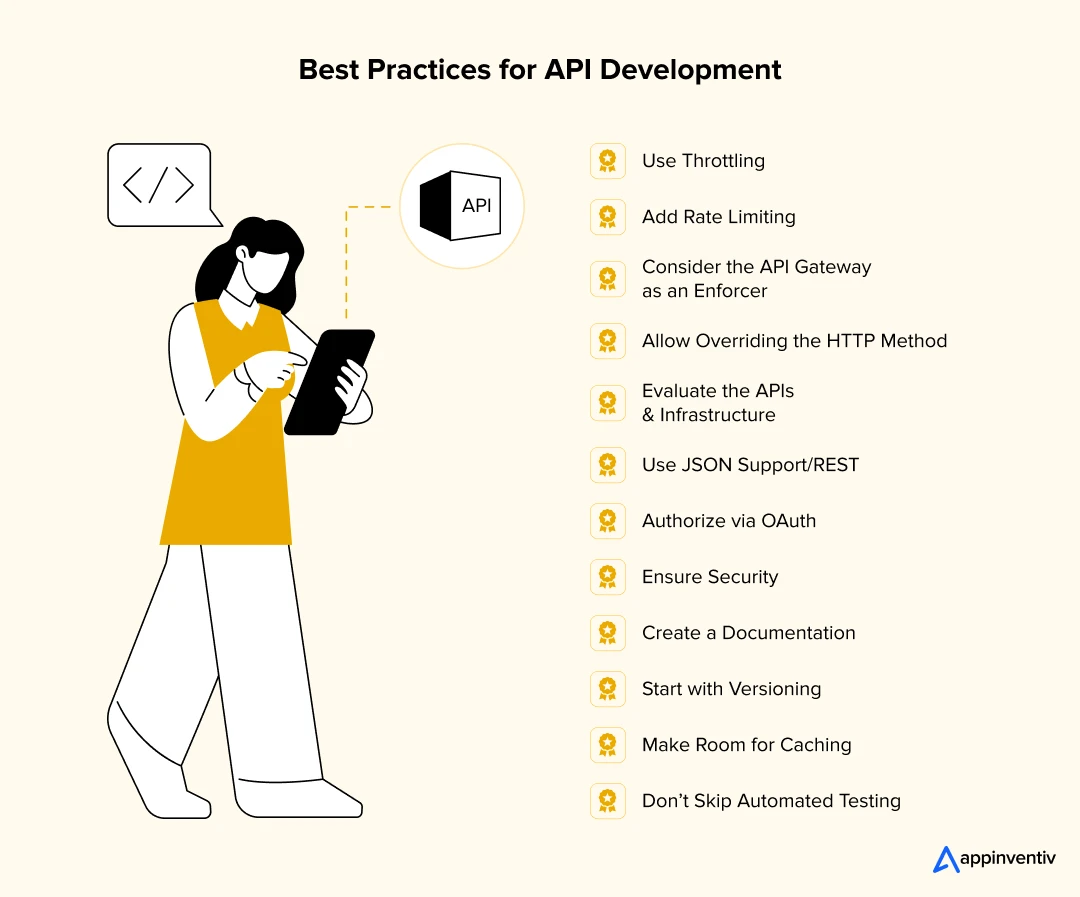
Use Throttling
App Throttling is a great practice to consider for redirecting traffic overflow, backing up APIs, and safeguarding them from DoS (Denial of Service) attacks.
Add Rate Limiting
While throttling helps in short bursts of traffic, rate limiting keeps users within defined usage limits over time, providing an extra layer of API protection. For example, you set a Limit of 1000 API requests per day. When the user hits the 1001 request, the server will send 429 messages as HTTP status to the end user along with the message, “Too Many Requests.”
Consider the API Gateway as an Enforcer
API Gateway is the most crucial consideration while pondering API development best practices. While setting up throttling rules, applying API keys, or using OAuth, the API gateway must be considered the enforcement point. It should be taken as a cop that lets only the right users access the data. It should empower you to encrypt messages or edit confidential information and thereby analyze and manage how your API is being used.
Allow Overriding the HTTP Method
Since some proxies only support GET and POST methods, you need to let your RESTful API override the HTTP method. For doing so, employ the custom HTTP Header X-HTTP-Method-Override.
Evaluate the APIs and Infrastructure
At present, real-time analysis is possible, but what if the API server is suspected to have memory leaks, a draining CPU, or other such issues? You can’t keep a developer on duty to consider such situations. However, you can perform this easily using numerous tools available in the market, like AWS CloudWatch.
Use JSON Support/ REST
Though not compulsory, it is good to consider your API to be RESTful (or provide JSON support (REST)) for effective API development. REST APIs are stateless and lightweight and let you retry the upload mobile app process if it fails. This is quite tough in the case of SOAP. Besides, JSON, with its readable syntax and compatibility with most programming languages, makes it easy for a mobile app developer to parse it into any other language.

Authorize via OAuth
Implementing OAuth in your API is ideal for secure and efficient user authentication. It enables faster, token-based access without requiring users to share credentials, often with just a single click. This method is widely trusted for securing APIs in modern applications.
Ensure API Security
You must ensure your API technology is secure, but not at the cost of user-friendliness. If any user spends more than 5 minutes on authentication, it means that your API is far from being user-friendly. You can use token-based authentication to make your API secure.
Start with Versioning
As your API evolves, versioning helps you roll out changes without breaking things for existing users. Whether using URI-based (/v1/users) or header-based versioning, this small step goes a long way in managing updates cleanly.
Make Room for Caching
Instead of fetching the same data repeatedly, implement caching strategies like ETags or Cache-Control headers. It reduces server load and improves speed, especially for read-heavy APIs.
Create a Documentation
It is profitable to create extensive documentation for an API for mobile apps. It lets other mobile app developers easily understand the whole process and utilize the information to offer a better user experience. In other words, good API documentation in the process of effective API development will lessen the project implementation time and cost and boost API technology efficiency.
Don’t Skip Automated Testing
Last but not least, conduct automated testing. Regular testing with tools like Postman, Swagger (OpenAPI), or CI-integrated test suites can catch bugs early and ensure your API performs as expected through every change.
Schedule a Free API Consultation with Our Solution Architects
Get Custom API Strategies Aligned to Your Business Goals
Discover How We Build Seamless, Compliant Integrations at Scale
API Development Challenges and How to Overcome Them
Developing an API is not just about writing code—it’s about building secure, scalable, and high-performance connections that can handle complex workflows and future demands. Enterprises face several common hurdles during the API development process, from design limitations to regulatory risks. Addressing these challenges early is key to building APIs that perform consistently and scale reliably.
Here’s a detailed look at the top challenges in API development and strategies to overcome them.
| Challenge | Solution |
|---|---|
| Designing Flexible Yet Consistent APIs | One of the core challenges in API software development is balancing flexibility with consistency. When creating APIs, enterprises often struggle with inconsistent naming conventions, unpredictable endpoint structures, and disconnected design patterns across teams. The solution is to adopt an API-first development approach with standardized design principles, comprehensive API documentation, and clear governance policies to ensure a unified structure that scales. |
| Ensuring API Security | Security remains one of the biggest challenges in API development. APIs often handle sensitive data and serve as integration points for external platforms, increasing the risk of unauthorized access. Enterprises focusing on building APIs must incorporate OAuth 2.0 authentication, token-based access, encrypted data transmission, and regular security audits to safeguard the entire API ecosystem. |
| Scaling to Handle High Traffic | A frequent bottleneck in developing APIs is their inability to handle rapid traffic growth without performance degradation. This can cause downtime, slow response times, or even complete system failure. To build scalable APIs, enterprises should implement API gateways, caching layers, and throttling mechanisms. Designing for scalability from day one ensures the API can handle traffic spikes and support future business growth. |
| Meeting Compliance Requirements | Regulatory compliance is a critical consideration when planning API development for global platforms. APIs that handle financial transactions, healthcare records, or personal data must align with GDPR, HIPAA, PCI DSS, and other international standards. Compliance should be built into the API development process through security enforcement, detailed audit logs, and clear data access controls. |
| Managing Complex API Versioning | Enterprises often overlook version control, leading to API updates that break existing integrations. Poor version management increases system fragmentation and frustrates API consumers. The solution is to implement strict API versioning policies, backward compatibility support, and structured deprecation timelines. This allows API developers to introduce improvements without disrupting client systems. |
| Handling Inconsistent API Documentation | Inadequate or outdated documentation is a significant barrier to API adoption. APIs that lack clear guidelines slow down developer onboarding and increase the risk of integration errors. Comprehensive documentation should be prioritized when creating APIs to ensure faster time-to-market and a seamless developer experience. Tools like Swagger (OpenAPI) can help automate and maintain high-quality documentation throughout the API lifecycle. |
| Managing Third-Party API Dependencies | When enterprises rely heavily on third-party APIs, they face risks related to service outages, pricing changes, or sudden deprecations. This is especially critical when developing an API that depends on external systems for core functionality. Businesses should build fallback mechanisms, set up real-time monitoring, and regularly assess third-party API health to mitigate dependency risks. |
| Maintaining Real-Time Performance and Low Latency | Enterprises developing APIs for real-time applications often face challenges in delivering low-latency responses under heavy load. Real-time APIs require optimized backend infrastructure, efficient database queries, and minimal processing layers. Integrating caching, reducing payload sizes, and using content delivery networks (CDNs) can significantly improve API performance. |
| Supporting Multi-Platform API Integration | APIs often need to integrate seamlessly across web, mobile, cloud, and IoT platforms. Supporting these diverse environments without creating multiple redundant APIs is a common challenge. Enterprises should invest in API development technologies that offer cross-platform compatibility and flexible deployment options to simplify multi-platform integration. |
| Ensuring Continuous API Monitoring and Maintenance | Many businesses overlook post-deployment monitoring of the software for API, which can lead to security gaps and performance issues over time. Effective API management requires real-time monitoring dashboards, error tracking, and automated alert systems. Enterprises focusing on building an API that remains reliable over the long term must integrate ongoing maintenance and monitoring into their governance frameworks. |
Understanding the API Development Cost
The cost of developing an API can vary significantly based on several factors. It includes but are not limited to, API features, its complexity, best practices used for API development, integration needs and so on.
Factors like security protocols, scalability requirements, compliance needs such as HIPAA or GDPR, and the number of endpoints all influence the final budget. Additionally, investing in thorough documentation, testing, and post-deployment support may add to the initial cost but significantly improve the API’s long-term value and usability.
On average, API development costs range between $30,000 and $300,000 or more. For instance, a simple API that performs basic CRUD operations can cost around $30,000 to $100,000. However, more advanced APIs that include authentication, rate limiting, data filtering, caching, AI integration, IoT connectivity, etc., can push the cost upwards of $100,000 to $300,000 or more.
| API Type | Cost Range | Timeline |
|---|---|---|
| Simple API | $30,000 – $100,000 | 4 to 6 months |
| Advanced API | $100,000 – $300,000+ | 6 to 9 months or longer |
Also Read: Mobile app development cost in 2025
API Monetization Strategies: Building New Revenue Channels
APIs have evolved from being purely technical assets to becoming significant commercial products. Enterprises across industries are now focusing on developing APIs not only to improve operational efficiency but also to create scalable revenue streams. API monetization has become a core part of digital strategy, enabling businesses to turn their APIs into profit-generating platforms.
Here are some of the most effective strategies to monetize APIs successfully.
Usage-Based Pricing
In the usage-based pricing model, customers are charged based on the number of API calls, the amount of data processed, or the transaction volume. This is one of the most common monetization approaches in API software development because it directly links revenue with customer engagement and API consumption.
This model is particularly effective when creating APIs for payment processing, location-based services, or communication tools, where customer usage can vary significantly across accounts.
Freemium to Premium API Access
Freemium API access allows businesses to offer basic API functionality for free, while premium features, higher usage limits, or advanced analytics are reserved for paid plans. This model encourages broad adoption initially, while opening up opportunities to upsell advanced services later.
It is often used when developing APIs for SaaS platforms or API for mobile apps, where scaling the user base quickly is a key growth driver. The freemium approach also provides developers with a low-risk way to explore API functionality before committing to paid plans.
Revenue Sharing with Partners
Enterprises can also generate revenue by offering APIs to partners through revenue-sharing agreements. In this model, APIs enable third-party platforms to build their services while the API provider earns a share of the revenue created.
For example, developing an API for payment processing or logistics tracking that integrates with partner platforms can create shared value for both companies. Revenue sharing helps businesses expand their reach while generating passive income through partner-driven transactions.
The Future of APIs: Powering the Next Digital Revolution
The modern business world is rapidly shifting toward an API-first development approach. Enterprises now manage an average of over 15,000 APIs as part of their digital transformation efforts. This strategy enhances scalability and flexibility and accelerates time to market for new applications and services.
In the coming years, several key trends and technologies are set to redefine the future of API development. Let us look at them in detail below:
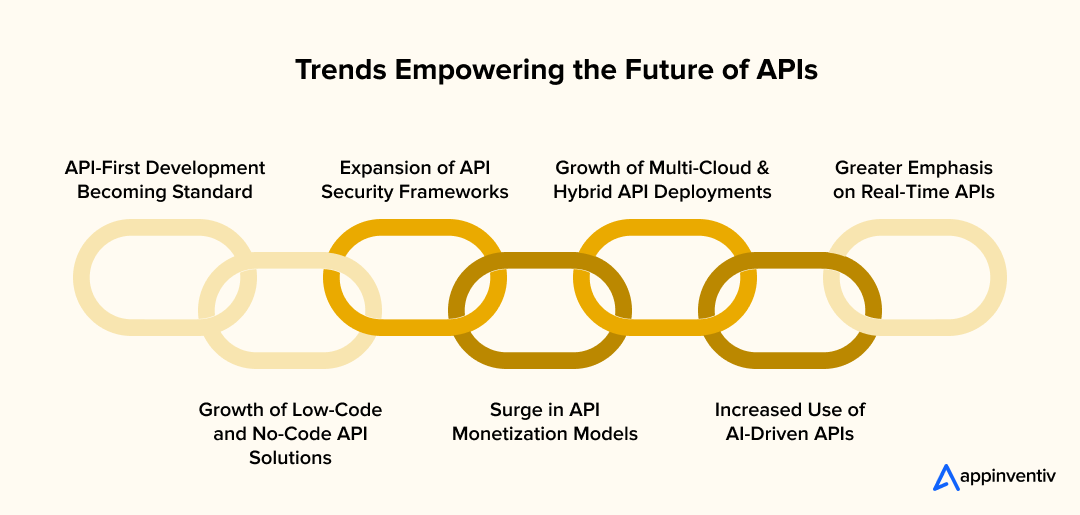
API-First Development Becoming Standard
The shift toward API-first development ensures that APIs are not an afterthought but the foundation of new digital products. Businesses looking to find best ways for how to build an API are prioritizing early design, consistent documentation, and seamless cross-platform integration. This trend accelerates development cycles and improves scalability. Creating APIs with this mindset helps enterprises build future-ready systems.
Growth of Low-Code and No-Code API Solutions
Low-code and no-code tools are simplifying API software development, making it accessible to non-technical teams. These API development platforms enable faster API creation, reducing the time to market and development costs. Enterprises are leveraging these solutions to scale quickly. This trend supports agile delivery without compromising functionality.
Expansion of API Security Frameworks
As businesses increasingly rely on APIs, API developers must integrate advanced security measures from the start. New security frameworks now include OAuth 2.0, token-based access, and real-time threat detection as part of the API development process. Enterprises are focusing on secure API development technologies to protect sensitive data. Security-first APIs are becoming a competitive necessity.
Surge in API Monetization Models
Enterprises are moving beyond using APIs purely for connectivity and are now treating them as commercial assets. Businesses are developing flexible monetization strategies while focusing on creating APIs that can scale and generate revenue. Usage-based pricing, freemium tiers, and partner revenue sharing are gaining traction. This trend is making APIs key drivers of growth.
Growth of Multi-Cloud and Hybrid API Deployments
Multi-cloud strategies are pushing API development technologies to support seamless deployment across diverse environments. APIs must now connect systems in public clouds, private clouds, and on-premise infrastructure. Businesses focusing on creating APIs need to ensure they remain compatible and scalable across platforms. Hybrid API deployment enhances flexibility and system resilience.
Increased Use of AI-Driven APIs
The integration of AI capabilities into APIs is transforming how enterprises deliver intelligent services. Businesses are now embedding machine learning, predictive analytics, and natural language processing into API workflows. AI-driven APIs offer faster decision-making and highly personalized customer experiences. This trend is reshaping API innovation.
Greater Emphasis on Real-Time APIs
Real-time data exchange is now a priority for modern APIs, especially in industries like FinTech, logistics, and healthcare. Enterprises are increasingly developing APIs that deliver instant responses and live updates. Real-time APIs require low latency, high availability, and efficient backend infrastructure. This trend supports the growing demand for seamless, immediate interactions.
Partner with Appinventiv for Efficient API Development
APIs are an integral part of custom app development. They are the connecting tissue that allows different systems to talk to each other. You can use this blog as your torchbearer on the path of API development. However, collaborating with a trusted API development services provider is still non-negotiable.
We are a premium provider of API and mobile app development services, specializing in designing secure, scalable, and high-performance APIs tailored to your business needs.
Whether you want to build a simple internal API or a complex enterprise-grade integration, our team of 1600+ tech experts puts their exceptional expertise and insight into every project, ensuring success and future readiness.
Contact us and elevate your digital transformation journey with secure and scalable future-ready APIs.
FAQs
Q. How to create an API from scratch?
A. To create an API, define endpoints, choose a framework (e.g., Flask, Express), set up a server, and code routes to handle requests. Use REST or GraphQL, test with tools like Postman, and deploy on platforms like AWS or Heroku. Ensure security with authentication (e.g., OAuth) and document using Swagger.
Q. What is an API in software development?
A. API is a collection of instructions and requirements that let a software or mobile application utilize the features/services of other applications, platforms, or devices for exceptional services.
There are basically different types of API:-
- Web service APIs
- WebSocket APIs
- Library-based APIs
- Object remoting APIs
- Class-based APIs
- Hardware APIs, etc.
Q. What is REST API development and SOAP API?
A. REST (Representational State Transfer) API is an architectural software style that describes a complete set of constraints that are employed for building web services. On the other hand, SOAP (Simple Object Access Protocol) is a much complex protocol, adding more standards than REST, such as security
Q. How do I make a good RESTful API?
A. Making a good RESTful API is easier when you follow these practices:-
- Use Throttling
- Consider your API Gateway as an Enforcer
- Allow overriding the HTTP method
- Make proper documentation
- Determine the APIs and infrastructure
Q. What is JSON API?
A. JSON (JavaScript Object Notation) is an encoding scheme created to eradicate the need for an ad-hoc code for each app to interact with servers in a particular manner.
Q. How to build an API that’s secure and scalable?
A. To understand how to make an API that is secure and scalable, you need to start with solid API design principles—use REST or GraphQL, apply versioning, and validate all inputs. Implement authentication (OAuth 2.0 or API keys), rate limiting, and logging. For scalability, deploy using cloud services (like AWS or Azure) and containerize with Docker.
Q. How to develop an API that integrates with third-party services?
A. To understand how to develop an API that integrates seamlessly with third-party services, businesses like yours must start by carefully studying the third-party API documentation to understand their authentication methods, data formats, and rate limits. When creating APIs for such integrations, ensure your API structure can handle external requests, webhooks, and error handling effectively. It is essential to build robust authentication layers, often using OAuth 2.0 or API keys, to secure data exchange. Additionally, you should design flexible endpoints that can process, transform, and relay data between systems smoothly. Furthermore, enterprises must also consider implementing retry mechanisms and real-time monitoring to manage third-party API failures and maintain a stable user experience.
Q. How does using an API for mobile apps improve performance and user experience?
A. Using an API for mobile apps streamlines communication between the app and backend services. It enables real-time data updates, faster load times, and smooth third-party integrations like maps, chat, or payments—resulting in a more responsive and engaging user experience.
Q. How long does it take to build an API?
A. The time required to build an API typically ranges from 3 months to 1 year or more, depending on the features, complexity, tech stack selection, and other vital factors.
- Simple API development that performs basic operations like data retrieval or updates can take 3 to 6 weeks.
- Complex APIs involving authentication, real-time data processing, third-party integrations, or high security standards can take 6 to 9 months or longer.
Contact an API development company to get a more precise estimate for API development cost and timeline.
Q. Why do enterprises need custom API development?
A. Enterprises need custom API development to build tailored, secure, and high-performance connections that meet their unique business goals and complex system requirements. Here are some of the benefits of API development for enterprises:
- Seamless Integration: Custom APIs enable smooth connectivity between legacy systems, modern applications, and third-party platforms.
- Scalability: Custom-built APIs can scale effortlessly with growing user bases and evolving enterprise workloads.
- Enhanced Security: Enterprises can embed specific security protocols suited to their industry and data sensitivity.
- Process Optimization: APIs can automate workflows, reduce manual intervention, and improve operational efficiency.
- Regulatory Compliance: Custom APIs can be designed to fully comply with sector-specific regulations like GDPR, HIPAA, and PCI DSS.
- Competitive Advantage: APIs built for your business create unique, high-value customer experiences that off-the-shelf solutions cannot deliver.
Q. How can APIs support digital transformation in large organizations?
A. APIs play a critical role in enabling digital transformation by creating a connected ecosystem where data and services can flow seamlessly across departments, platforms, and partner systems. They simplify system modernization, support the adoption of cloud technologies, and accelerate time-to-market for digital products. Custom APIs built in collaboration with a trusted API development services partner allow large enterprises to integrate emerging technologies like AI, IoT, and big data solutions, helping them scale rapidly, improve operational efficiency, and deliver exceptional customer experiences.


- In just 2 mins you will get a response
- Your idea is 100% protected by our Non Disclosure Agreement.

A Comprehensive Guide on Typography in App UI Design
“The text is too big.” “The words are placed too distantly.” “The words are not going with the image!!” Such comments have been passed continuously ever since the day user experience established itself as a crucial element of the mobile app design industry. Typography is ubiquitous! You look anywhere, from books to websites to your…
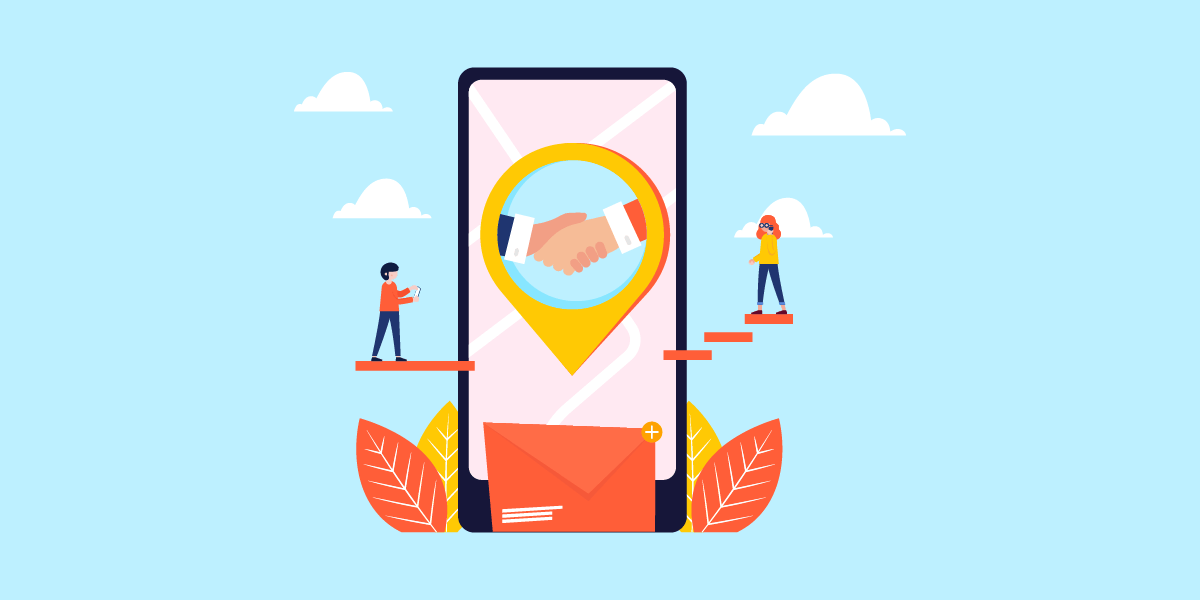
The Essential Guide For When to Add Geolocation in Your App and How
There was once a time when people used to think a million times before giving out their address to an unknown person or business. Today, people are more than willing to give out their addresses to businesses and applications if it would translate into them getting better services or a more personalized product offer. Such…

How to Validate an App Idea Successfully
Getting an app idea is easy. How many times have you found yourself looking at something – an event, an issue, or simply a situation and - thinking how easy it would have been if there was an app for that? Such instances have led to the creation of many millions of apps that are…


